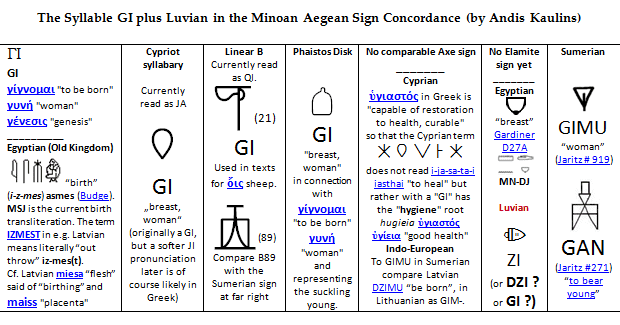(continued from GE Luvian Update)
This posting updates the series started here by adding Luvian (also spelled Luwian, formerly Hieroglyphic Hittite) to the syllabic grid for the syllable GI originally published at 59 - The Syllable GI : Origins of Writing in Western Civilization and the Kaulins Minoan Aegean Sign Concordance (MinAegCon™): A Syllabic Grid of Mycenaean Greek Linear B Script, the Cypriot Syllabary, the Phaistos Disk, two Old Elamite Scripts, the Inscription on the Axe of Arkalochori, and Comparable Signs from Sumerian Pictographs and Egyptian Hieroglyphs.
If I have found no comparable Luvian syllable in mainstream sources, there is no update posting for that syllable. This applies particularly to syllables with the vowel "O", which predecessor Sumerian did not have (apparently also not in Luvian). Syllables with the vowel "E" are alleged by Luvian scholars not to have been used for Luvian, though I think otherwise. My research indicates that also Luvian had "consonant plus vowel E" (or similar sound) syllables and I include them if I have been able to identify them (provisionally, of course, subject to ultimate confirmation).
Each syllable will be presented in its own posting.
There is first a scanned image of a "syllabic" grid excerpt from the original Microsoft Word manuscript -- the links there are not clickable because it is one image.
The original text follows -- the links there are clickable -- but embedded fonts or images may be missing because Blogger does not pick them all up from Microsoft Word, so use the scanned image for those.
The Syllable GI plus Luvian in the Minoan Aegean Sign Concordance (by Andis Kaulins)
ΓΙ GI γίγνομαι "to be born" γυνή "woman" γένεσις "genesis" __________ Egyptian (Old Kingdom) “birth” (i-z-mes) asmes (Budge). MSJ is the current birth transliteration. The term IZMEST in e.g. Latvian means literally “out throw” iz-mes(t). Cf. Latvian miesa “flesh” said of “birthing” and | Cypriot syllabary Currently read as JA � � GI „breast, woman“ (originally a GI, but a softer JI pronunciation later is of course likely in Greek) | Linear B Currently read as QI. � �(21) GI Used in texts � �(89) Compare B89 with the Sumerian sign at far right | Phaistos Disk � � GI "breast, woman" in connection with "to be born" "woman" and representing the suckling young. | No comparable Axe sign _______ Cyprian ὑγιαστός in Greek is "capable of restoration to health, curable" so that the Cyprian term �� �� �� �� �� does not read i-ja-sa-ta-i iasthai "to heal" but rather with a "GI" has the "hygiene" root Indo-European To GIMU in Sumerian compare Latvian DZIMU “be born”, in Lithuanian as GIM-. | No Elamite sign yet _______ Egyptian “breast” MN-DJ Luvian 5 ZI (or DZI ? or GI ?) | Sumerian GIMU “woman” GAN |



 -----
-----
